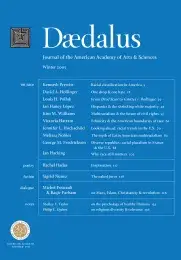Race on the 2010 census: Hispanics & the shrinking white majority
At our country’s founding, we made race the constitutional test for those capable of self-government. Our nation’s organic document allocated congressional seats among the states in proportion to “the whole Number of free Persons . . . excluding Indians not taxed [and] three fifths of all other Persons.”1 The Constitution then commanded that a census divine those racial numbers every ten years. From its first enumeration in 1790, the decennial census formed part of the process by which the racial state elaborated itself and society, race and democracy.
In the two centuries plus since, every census has tabulated the number of “white” persons in the United States.2 The original Constitution clearly envisioned a polity comprised of whites– they would be, as the Census Bureau put it in 1852, “the governing race.”3 And whites have remained politically, economically, and socially dominant, notwithstanding the Reconstruction amendments that ended the explicit allocation of political representation along racial lines. The modern census shows that by almost every relevant sociological measure, whites continue to occupy the superior position in American society.
But a demographic revolution is underway, partly as a result of a long history of U.S. expansion, colonial incursions, and gunboat diplomacy throughout the Western Hemisphere. Latin Americans for several decades have composed the largest immigrant group in the United States, and this trend will continue, if not accelerate. Not even closing the border would significantly disrupt this development. Domestic births currently outpace immigration as the primary source of Latino population growth, with births to Hispanic mothers outnumbering all other deliveries combined in bellwether California. The U.S. Latino population increased 58 percent between 1990 and 2000, and this group, the largest minority in the country, now accounts for more than one of every eight Americans.4 The Census Bureau conservatively estimates that by 2020 Latinos will number 17 percent of the country.
What, then, of the white population in 2020? The Census Bureau projects that whites will still constitute a comfortable majority at 79 percent. But it gets this figure only by including ‘Hispanic whites,’ those Latinos who identify as racially white on the census. Without those Latino millions, the Bureau estimates that in the next fifteen years whites will fall to just sixty-four of every hundred Americans.5
So there it is: if Latinos are not counted as white, then whites within a few years will barely comprise three-fifths of all Americans, and not too long after that, probably before 2050, a numerical minority. . . .
